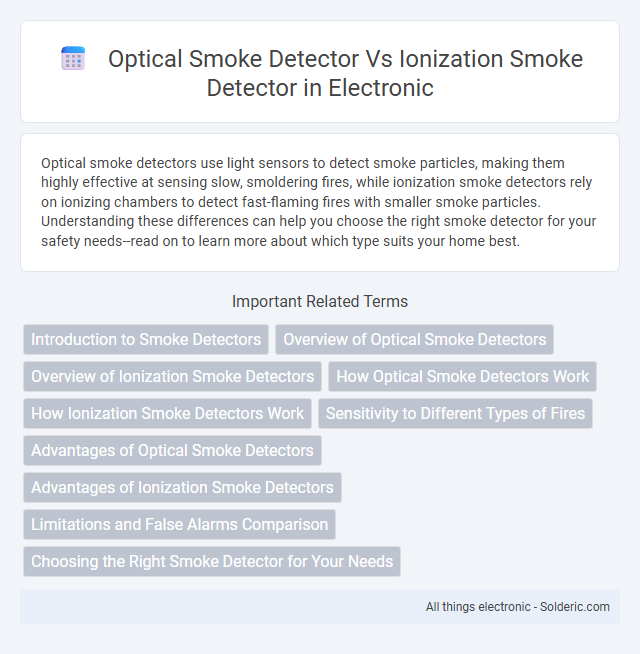Optical smoke detectors use light sensors to detect smoke particles, making them highly effective at sensing slow, smoldering fires, while ionization smoke detectors rely on ionizing chambers to detect fast-flaming fires with smaller smoke particles. Understanding these differences can help you choose the right smoke detector for your safety needs--read on to learn more about which type suits your home best.
Comparison Table
| Feature | Optical Smoke Detector | Ionization Smoke Detector |
|---|---|---|
| Detection Method | Uses light scattering to detect smoke particles | Uses ionization chamber to detect smoke ions |
| Best for | Detecting smoldering fires with thick smoke | Detecting fast-flaming fires with small particles |
| Response Time | Slower to react to rapid flaming fires | Faster response to fast, flaming fires |
| False Alarms | Less prone to false alarms from cooking | More prone to false alarms from cooking fumes |
| Maintenance | Requires occasional cleaning of sensor chamber | Requires battery replacement and periodic testing |
| Cost | Generally slightly higher cost | Generally lower cost |
| Safety | No radioactive material used | Contains small amount of radioactive material (Americium-241) |
Introduction to Smoke Detectors
Optical smoke detectors use a light sensor to detect smoke particles through light scattering, making them highly effective at detecting smoldering fires. Ionization smoke detectors employ a small amount of radioactive material to ionize air and sense changes caused by fast-flaming fires. Both types are crucial in fire safety, with optical detectors preferred for early detection of slow-burning fires and ionization detectors better at identifying rapid flames.
Overview of Optical Smoke Detectors
Optical smoke detectors use a light source and a photodiode to detect smoke particles by measuring light scatter within a sensing chamber, making them highly effective at identifying smoldering fires with larger smoke particles. These detectors typically respond slower to flaming fires but excel in early warning for slow, smoldering combustion commonly found in residential settings. Their low false alarm rate and sensitivity to visible smoke make optical detectors a reliable choice for enhancing fire safety in homes and offices.
Overview of Ionization Smoke Detectors
Ionization smoke detectors utilize a small amount of radioactive material to ionize air within a sensing chamber, allowing current to flow continuously under normal conditions. When smoke particles enter the chamber, they disrupt the ionization process, reducing current and triggering the alarm. These detectors are highly sensitive to fast-flaming fires producing small combustion particles but less effective against smoldering fires with larger smoke particles.
How Optical Smoke Detectors Work
Optical smoke detectors operate using a light source and a photodetector arranged inside a sensing chamber. When smoke particles enter the chamber, they scatter the light, causing a change in light intensity detected by the photodetector, which triggers the alarm. This mechanism makes optical smoke detectors particularly effective in identifying smoldering fires with larger smoke particles.
How Ionization Smoke Detectors Work
Ionization smoke detectors use a small amount of radioactive material to ionize the air between two electrodes, creating a current that is disrupted when smoke particles enter the chamber. This disruption triggers the alarm, making ionization detectors highly sensitive to fast-flaming fires producing small combustion particles. Understanding how ionization smoke detectors work helps you choose the right device for detecting rapid, high-intensity fire threats in your home or business.
Sensitivity to Different Types of Fires
Optical smoke detectors excel in detecting smoldering fires by using a light sensor to identify smoke particles, making them highly sensitive to slow, smoldering fires that produce larger smoke particles. Ionization smoke detectors are more responsive to fast-flaming fires due to their ability to detect smaller combustion particles via ionized air. For your home safety, choosing the right detector depends on the predominant fire risk, with optical models better for smoldering scenarios and ionization units for rapid flame fires.
Advantages of Optical Smoke Detectors
Optical smoke detectors use light scattering technology, making them highly sensitive to smoldering fires and producing fewer false alarms compared to ionization detectors. These detectors offer faster response times to smoky, smoldering fires, enhancing early detection and safety in your environment. Their low maintenance and resistance to environmental pollutants provide reliable performance, especially in residential and commercial settings.
Advantages of Ionization Smoke Detectors
Ionization smoke detectors excel at detecting fast-flaming fires by sensing tiny smoke particles through ionized air flow, providing quicker alerts in such scenarios. Their sensitivity to smaller smoke particles allows for early warning in fires that produce minimal visible smoke. If you need reliable detection for rapidly spreading fires, ionization detectors offer a significant safety advantage over optical detectors in these specific situations.
Limitations and False Alarms Comparison
Optical smoke detectors often face limitations in detecting fast-flaming fires due to their reliance on smoke particle scattering, leading to possible delays in alarm activation. Ionization smoke detectors are more prone to false alarms triggered by cooking fumes or steam because of their sensitivity to smaller combustion particles. Both types require strategic placement and regular maintenance to minimize false alarms and ensure optimal fire detection performance.
Choosing the Right Smoke Detector for Your Needs
Optical smoke detectors use light sensors to detect smoky particles, making them highly effective for sensing smoldering fires, while ionization smoke detectors respond faster to flaming fires by detecting ionized particles. Your choice should consider the environment where the detector will be installed; optical detectors excel in residential settings with slow-burning fires, and ionization types are better suited for detecting fast, flashy fires. Selecting the right smoke detector enhances early fire detection and safety tailored to your specific risk factors.
Optical smoke detector vs ionization smoke detector Infographic

 solderic.com
solderic.com